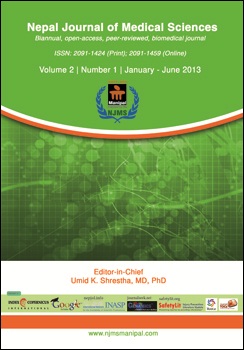Non-operative Management of Blunt abdominal trauma in a Tertiary Care Hospital of Nepal
DOI:
https://doi.org/10.3126/njms.v2i1.7650Keywords:
Non-operative Management, blunt abdominal trauma, liver trauma, spleen traumaAbstract
Background: To assess the feasibility of Non-operative management of Blunt abdominal trauma in a teaching hospital of Nepal.
Methods: A prospective observational study was carried out over a period of 3 years including 52 cases of blunt abdominal trauma in a teaching hospital in western part of Nepal. Patient and trauma characteristics of the cases, different modalities of treatment and outcomes were evaluated. All the cases were divided in 3 groups: Operative group, Non-Operative Management and Non-Operative Failure group. Operative group and non-operative management group were compared using Fischer Exact Test for categorical variable and student’s “t” test for continuous variable.
Results: There were 36% of cases in operative group, 61% in non-operative management group and 2% in non-operative management failure group. Non-operative management was successful in 97% of cases. Injury severity score, admission hematocrit and hemodynamic status were significantly different between non-operative management and Operative group. Non-operative management failure occurred in 1 case and was secondary to delayed hepatic hemorrhage.
Conclusion: Non-operative management of Blunt abdominal trauma can be attempted with high degree of success. Hemodynamic and clinical instability rather than severity of the organ injury is the predictor of failure in non-operative management. Spleen and bowel injury are the most common organ that usually land up in operative group because of hemodynamic instability in splenic injury and peritoneal contamination in bowel injury. Close surveillance in an intensive care unit is always desirable.
Nepal Journal of Medical Sciences | Volume 02 | Number 01 | Jan-Jun 2013 | Page 38-41
Downloads
Downloads
Published
How to Cite
Issue
Section
License
Copyright © by Nepal Journal of Medical Sciences. The ideas and opinions expressed by authors of articles summarized, quoted, or published in full text in this Journal represents only opinions of authors and do not necessarily reflect the official policy of Nepal Journal of Medical Sciences or the institute with which the author(s) is (are) affiliated, unless so specified.




